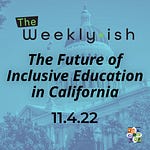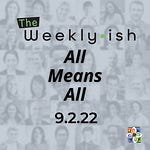Hi, Y’all!
This week, I celebrated my two-year anniversary at MCIE.
That’s right. I left my job at a public school district in the Atlanta Metro area to work in the nonprofit sector, and it’s been a huge learning curve.
You see, I used to be a special education teacher. That was my role for 16 years. 13 of those were in the classroom, and 3 were in a district support specialist role. And the whole time I was in the special education department of the districts I worked for, there was something that bothered me. Segregated special education classrooms.
You probably already know about this, but just in case you don’t know, here is a simplified explanation.
Public education is split into two systems. General education and special education. They are supposed to work together to meet the needs of all learners but to be honest it rarely happens. Real talk...it is hard to change a system that is set up to separate learners in the first place.
There was a law passed in 1975, which had a funny name (PL 94-142) and then after a few years it was called the Individuals with Disabilities Education Act. That law made it so that learners with disabilities had a legally protected right to be educated in public schools. Before that law, they were often educated in separate schools or institutions, or if they did go to a regular school, they were not treated that great.
But then as learners started attending their neighborhood schools, school leaders didn’t necessarily want them there because they thought it would be a distraction or that they were too disabled to learn with everyone else. So, they were put in separate classrooms. And a lot of people thought this was a good idea. But not everyone.
As time passed, organizations like MCIE started helping school districts make changes in how they taught all learners. Specifically, how they supported learners with significant disabilities in general education classrooms. And when I mean significant disabilities, I mean learners on the autism spectrum, those with presumed intellectual disabilities, and challenging behavior among others who have been historically excluded. Researchers, school administrators, and teachers all were learning that when school met the needs of all learners in a systematic way rather than by segregating students by disability everyone benefitted.
When I entered the field of special education in 2004, the inclusive education movement had already gone through its biggest push in the 1990s. But in my teacher education program, they taught me all about how learners should be together, how general and special education teachers could collaborate to plan for every child in the classroom, and by distributing students with high support needs across a grade level it kept certain classrooms from having more learners with disabilities than other ones.
But then when I entered the school system, I realized this is not how schools are run.
Cal State Fullerton ruined me! Not really... I love all of you. But they did ruin me in the best way.
Because I spent essentially my whole career as an educator trying to change the system from within.
Why are you telling us this Tim? Well, we have some new people who have subscribed to The Weeklyish, and since I’m reflecting on the last two years, I wanted to share my story again. And give you my why.
Why is this important to me? You know I’ve been asked this question a number of times, and the best answer I can give is that I saw a need and something compelled me to devote myself to it. I suppose some people say it is a calling, and I can’t disagree. But for whatever reason, the fact that the vast majority of school districts segregate students by disability is to me a grand injustice. And I want to work toward righting that wrong because I do believe it is wrong. And it is not just a belief; we have evidence that it is not the best for kids.
And you know what I keep hearing out of the mouths of school leaders that segregate kids? “We do what’s best for kids.”
Here is what I say. No. You are not doing what is best for kids. You are doing what is the most convenient to sustain an inequitable system.
So, it is in that spirit that I wanted to share with you my favorite Weeklyish articles since I started writing this newsletter in January of 2020.
This first one is from February 2020, called On Separate Spaces, and Why They Are and Are Not Needed.
Here is the key takeaway. The goal is always 100% inclusive placement with support. But there are very rare instances where a learner may need something else, and though inclusionists don’t like to talk about it, it is a reality that I think hurts our credibility when we want to stick our head in the sand and pretend this scenario doesn’t exist.
Recently, I had a short Facebook exchange with a former colleague that addressed this.
Generally, if a learner truly needs to be removed, it should only be temporary. There should always be a plan to bring a learner back into the community where they belong. The problem with special education classrooms, as most districts have set them up, is these separate and segregated environments are the settings where they say students with extensive support needs belong. So, on the rare occasion that families (or educators) push for an inclusive placement, the minute things do not go perfectly, skeptics will point to that as an example of inclusion not working. But it can't just be one learner (or even a handful) for it to work. There has to be a commitment by the district to operate differently and have the expectations that all learners belong in a general education classroom. And then...and only then...if a learner needs an alternate setting, it is for a specific reason and only temporary because the classroom where they belong is waiting for them to return.
The next one, from January 2021, is called Let's Stop Pretending That We Can't Do Better Than Segregated Special Education Classrooms.
Here is an excerpt:
Educational research that has been around for decades has shown that inclusive education benefits students with and without disabilities. So why aren’t we doing it?
It was easy to try to rationalize why things were not changing fast enough when I worked in a system that wasn’t inclusive. But now that I am out, and working and talking with educators in school districts that are implementing inclusion the way that it was intended, there is simply no excuse for me not to state the obvious.
Let’s stop pretending that segregated special education classrooms are the best we can do.
I get that some may not be able to wrap their head around what this looks like. But fortunately, there are some excellent examples. All it takes is for a state or district administrator to investigate it for themselves.
And finally, from June 2021, my piece called, How to Include Students with Disabilities in General Education in 4 Easy Steps.
What you probably don’t know is that when I was first getting my blog and podcast Think Inclusive off the ground, I wrote a blog post called, Quit Using the R-Word in 3 Easy Steps (now only available on the Wayback Machine). So, the title is a bit of a throwback.
I like this one because it lays out the steps of moving toward a fully inclusive system. There is more to it of course, and it certainly isn’t easy, but it is a start and if there is anything that I want you to do after finishing this edition of The Weeklyish is start. Start anyway you can!
I know I’m not the only educator that sees the inherent problem with special education classrooms. This is your sign to do something about it. The first thing you can do is share this message with a friend, colleague, or family member. That’s your homework assignment. I still love to give homework.
That’s all the recommendations for past articles I have today.
As always, if you ever have questions or comments email me at tvillegas@mcie.org or go to mcie.org to learn more about how we can partner with you and your school or district.
Thanks for your time, everyone. I’ll be back in a couple of weeks with another edition of The Weeklyish.
Have a great week!
ICYMI
What Does Truly Meaningful Inclusion Mean to You?
Dr. Mona Delahooke | Beyond Behavior Charts and Positive Reinforcement
5 Ways to Get Inclusion Started at Your School
Mazey Eddings | Neurodiverse Representation in Books
Around the Web
How my school gets students to “behave”
Rethinking Guardianship: Emma’s Story
Airlines May Be Required To Accommodate Travelers In Their Wheelchairs
Schools Nationwide Expect Special Ed Teacher Shortages This Fall
What I’m Reading
What I’m Watching
Reservation Dogs (FX on Hulu) Trailer HD - Taika Waititi comedy series
What’s in my Pod Feed
467: Plot Twists (The Popcast With Knox and Jamie)
Evan Phillips: Founder Of Pod Peak Studios | From Mountain Climber to Podcast Producer (Clipped)
Podcasts about Work and Work Culture (Feedback with EarBuds)
All Means ALL – A Welcome from Sarolyn (All Means ALL Inclusive Education)
What I’m Listening To
Death Cab for Cutie - Here To Forever (Official Music Video)
What’s in my Timeline
Cultures don’t change because they’re ready. Cultures change because brave people make them ready.
Natalie Vardabasso (@natabasso)
From the Wayback Machine
9 Resources for Creating an Inclusive Classroom This School Year
Just Because
If my girlfriend actually turned into a worm
...
The Weeklyish is written, edited, and sound designed by Tim Villegas and is a production of MCIE.
Our intro stinger is by Miles Kredich.
And our outro is by REDProductions.
For information about inclusive education visit mcie.org and check out our flagship podcast, Think Inclusive, on your favorite podcast app.





![[image: Book Cover of Underestimated by J. B Handley and Jamison Handley] [image: Book Cover of Underestimated by J. B Handley and Jamison Handley]](https://substackcdn.com/image/fetch/$s_!RsKK!,w_1456,c_limit,f_auto,q_auto:good,fl_progressive:steep/https%3A%2F%2Fbucketeer-e05bbc84-baa3-437e-9518-adb32be77984.s3.amazonaws.com%2Fpublic%2Fimages%2Fd7cfd129-eacf-4206-8949-eac30c776252_602x900.jpeg)











